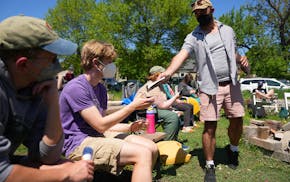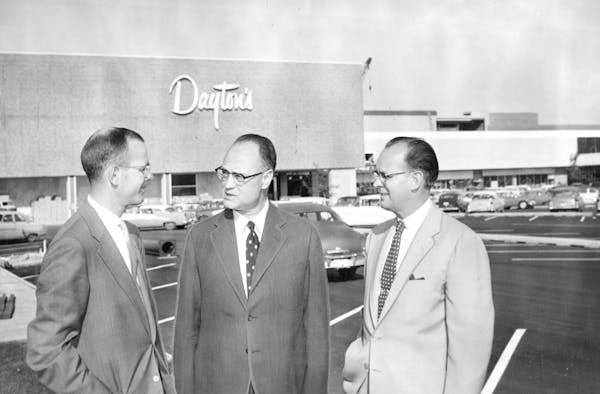Bruce Dayton, one of five brothers who used the Nicollet Avenue department store they inherited as the foundation to build what is now Target Corp., died Friday morning at 97.
Dayton, the father of Gov. Mark Dayton, was the bookish, numbers-oriented analyst among the five Dayton brothers, each of whom received 20 percent of the business after their father's death in 1950. The brothers expanded Dayton's to the suburbs, where it anchored the first indoor shopping mall in the United States, in Edina in the late 1950s. A few years later, they launched Target, which today has 1,800 stores and nearly 350,000 employees.
Bruce Dayton also was a legendary benefactor of the Minneapolis Institute of Art, where he was a trustee for 73 years and provided more than $80 million in financial support plus more than 2,000 works of art worth additional millions.
"We just lost a Minnesota giant," Vice President Walter Mondale said Friday morning.
Bruce Dayton's father and grandfather built their department store on Nicollet into a thriving retail showcase during the first half of the 20th century, employing such innovative and attention-getting tactics as shipping merchandise from New York City by airplane.
Bruce Dayton and his brothers diversified, positioning the company to shift its focus away from downtown department stores, and along the way did many things to help shape Minneapolis and its suburbs after World War II.
They embraced downtown skyways, helped push for a pedestrian mall on what became the Nicollet Mall and were steadfast supporters of a downtown that remains home to Target's headquarters.
"It's tough to assign specific roles to the Dayton brothers because they did so many things as a group," said James McComb, a Dayton Hudson executive in the 1960s and '70s. "But Bruce had the financial strength, Ken was the merchandiser, and they all had strong feelings about architecture."
In a 2008 book Dayton wrote called "The Birth of Target," he attributed the company's early success to harmony among the five brothers, a movement to professional management during the 1970s, and a commitment to ethical corporate governance and generous corporate and individual philanthropy tied to the communities that made them wealthy.
Bruce Dayton liked to point out that when he and his brothers took over in the years after World War II, Sears Roebuck was "40 times our size in terms of sales. Our small company eventually became Target Corp., now larger than Sears and Kmart combined. We must have done something right."
Target Chief Executive Brian Cornell said in a statement that the company's employees were saddened by the news of Dayton's death. "Bruce was a great man and a visionary retail and business leader," Cornell said. "Most importantly, he proved that you can both do good business and do good while doing business."
The Dayton brothers took over the business during a golden age for American department stores, when they epitomized fashion for much of the population.
For many aspiring sophisticates of that era, Dayton's exclusive Oval Room was a chic, mirrored landscape through which they could only drift and dream. Its presence lent a seductive touch of class that lured customers to other departments, as did the airy Sky Room lunchroom and the more masculine Oak Grill, and Gallery 12, the store's avant-garde art gallery that vied with Walker Art Center in bringing new talent to the Twin Cities.
Innovators
The Daytons were innovators, always looking for new retail opportunities. They played an integral role in the 1956 opening of Edina's Southdale shopping center, where Dayton's was the anchor tenant. Other Dayton-driven "dales" eventually would dot the Twin Cities landscape.
Cognizant of emerging trends, the brothers branched into discount retailing with the opening of the first Target store, in Roseville, in 1962. The marketing moxie and design sophistication for which Target became known carry a trace of Dayton company strategies from the 1950s and '60s, when the Nicollet Mall department store wooed customers with animated holiday displays, lavish spring flower shows, and designer merchandise from top-name Paris ateliers.
Bruce Dayton, the last of the five brothers to die, also launched the B. Dalton bookstore chain in 1966.
He was key to taking the family-owned Dayton company public in 1967 and merging it with Detroit-based Hudson's to form Dayton Hudson Corp., the predecessor to Target Corp.
Bruce Dayton stepped aside as CEO in the early 1970s in favor of his brother Kenneth.
"I realized that he was a better executive," Bruce Dayton once said of his brother. "One who could do a more effective job building the organization. … Titles were incidental. The only difference was that we used to meet in my office. Afterward, we met across the hall in his."
Bruce and Kenneth were the last brothers to leave the board of directors, in 1983.
For all of his success in business, Dayton was best known in later years for his contributions to the Minneapolis Institute of Art, where he was a trustee for 73 years, from 1942 until his death. Believed to be the country's longest-serving museum board member, he was described in a New York Times article as "a trustee's trustee" and a "shrewd collector with the taste of a connoisseur."
Mondale said that, during his time as vice president in the late 1970s, Dayton accompanied him on several international trips, including to China, and always made time for art. "He would visit the great art museums with my [late] wife, Joan," Mondale said. "That was one reason you have a great permanent collection at the MIA."
A lifelong art lover, Dayton began collecting early. He attended Blake School and graduated from Yale in 1940. He used college graduation gifts to buy his first original piece,a $125 Rembrandt etching that would cost many thousands now.
Over the decades, he has given the Minneapolis museum more than $80 million in capital support, plus helped launch endowments that now total $27.5 million. In 1989, he led a successful $50 million endowment campaign to support the museum's operations and education programs.
He has also donated more than 2,000 works of art in virtually every field from 19th-century French paintings and modern drawings to a Shoshone painted elk hide, Tiffany vases, and ancient Chinese furniture, sculpture and paintings.
'Sad day indeed'
"This is a very sad day indeed," said MIA President Kaywin Feldman. "Bruce's generosity and depth of commitment to our museum are unparalleled. He has given MIA so much throughout his life, through his active board participation, philanthropic support, connoisseurship, and remarkable insight. He helped shape us to be one of the greatest art museums in the country. Our gratitude to him is boundless. I will miss him very much."
Dayton typically avoided the limelight and rarely allowed buildings or galleries to be named after him. In 1997 he surprised museum officials with a $10 million gift of stock to support operations and Asian art programs, then the largest donation in the institute's history. After announcing the gift in a letter, he slipped off to Antigua where he could not be reached for comment.
Starting in the early 1990s, Dayton and his third wife, Ruth Stricker Dayton, began systematically to develop the museum's Chinese art collection, transforming it from a small but distinguished hoard of ancient bronzes and jades into a world-class collection of more than 1,400 items that fill 14 galleries and comprise a virtual museum-within-the-museum.
In 1996 Dayton paid a world-record $1.1 million at auction for a rare wood-and-marble Chinese screen, and later bought a complete Ming dynasty house and scholar's study and then paid for Chinese workmen to restore and install them at the museum.
"Dayton has had a tremendous impact on all of us and is an inspiration in so many ways to the next generation of community leaders, business owners, and others who knew him," MIA Board Chair Maurice Blanks said. "Bruce's great vision, involvement and investment with the museum has positioned us well for the next 100 years."
Dayton applied his sharp business acumen to museum affairs, too. He bought houses on Stevens Avenue to preserve the neighborhood on the museum's west side, and an old motel on the northeast corner of 24th Street and 3rd Avenue S. as a possible expansion site. The museum later razed the motel and built a parking lot. "This was all part of his dealing with the public at the retail level" said Robert Jacobsen, the institute's curator emeritus of Asian art, who worked closely with Dayton for more than 20 years.
Together, Bruce and Ruth Dayton sponsored shows at the China Institute in New York and gave $5 million to the art museum at Yale University, where the Asian galleries were renamed in their honor. In China, they provided major financial support to the Shanghai Art Museum and paid for the restoration of a 34-room Ming-dynasty villa from the late 1500s that is now a public museum.
They also informally adopted a young Chinese man, Andrew Wang, brought him to the United States after the Communist crackdown at Tiananmen Square in 1989, and supported him through college and graduate school. Wang, an award-winning calligrapher, completed a doctorate in electrical engineering at the University of California, Santa Barbara.
Dayton supported many other organizations, including the Walker Art Center, Minneapolis Public Library, Guthrie Theater, University of Minnesota's studio arts building, Macalester College in St. Paul and Yale University Art Gallery.
A quiet conservationist, he also donated 110 acres of pristine forest to the state Department of Natural Resources.
Born in Minneapolis in 1918, Dayton grew up Presbyterian and spent summers working at an 800-acre family farm on Lake Minnetonka for his father, George Nelson Dayton, who took over Dayton's Department Store from his father, George Draper Dayton, in 1923.
Bruce Dayton is survived by four children from his first marriage, to the late Gwendolen Brandt: sons Mark and Brandt, and daughters Lucy and Anne; two stepchildren, Kim Griffin and Mark Stricker, as well as 11 grandchildren and two great-grandchildren.
A memorial service is scheduled for 4 p.m. Thursday at Westminster Presbyterian Church in downtown Minneapolis.
Staff writers David Phelps and Adam Belz contributed to this report.
Mary Abbe • 612-673-4431
Neal St. Anthony • 612-673-7144

'Safe recovery sites' would offer syringes, naloxone and more to people using drugs. The plan could be in peril.
New Minnesota GOP leaders seek peace with party's anti-establishment wing

Who is Republican Lisa Demuth, Minnesota's first House speaker of color?

